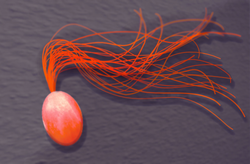| Thermococcaceae | |
|---|---|
 | |
| Painting simulating a SEM picture of Pyrococcus furiosus | |
| Scientific classification | |
| Domain: | Archaea |
| Kingdom: | Methanobacteriati |
| Phylum: | Methanobacteriota |
| Class: | Thermococci |
| Order: | Thermococcales |
| Family: | Thermococcaceae Zillig et al. 1988 [1] |
| Genera | |
Thermococcaceae is a family of archaeans in the order Thermococcales. [2] Almost all species within the three genera of Thermococcaceae were isolated from hydrothermal vents in the ocean. All are strictly anaerobes. [3]